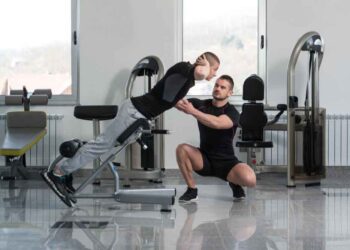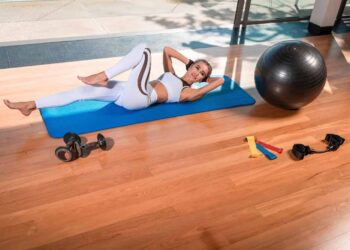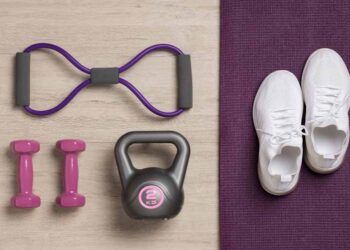Are high-intensity workouts on an elliptical effective? Let’s debunk the common misconceptions and reveal the truth about elliptical trainers. Many false beliefs surround these workouts, but understanding the reality can help you achieve your fitness goals efficiently.
Contrary to popular belief, high-intensity workouts on an elliptical trainer can be highly effective and beneficial. Many misconceptions and myths surround these workouts, leading to false beliefs about their effectiveness. In this article, we will debunk some of the most common myths about elliptical trainers and reveal the truth behind these misconceptions. By understanding the reality, you can maximize the results of your high-intensity elliptical workouts and achieve your fitness goals more efficiently.
Key Takeaways:
- Dispelling common misconceptions about elliptical trainers
- Understanding the truth behind the effectiveness of high-intensity workouts
- Maximizing results and achieving fitness goals with proper elliptical training strategies
- Debunking the top myths about elliptical trainers
- Putting false beliefs about elliptical machines to rest
Myth #1: “LISS Is Better Than HIIT For Fat Loss”
One common myth surrounding elliptical trainers is that low-intensity steady-state cardio (LISS) is better than high-intensity interval training (HIIT) for fat loss. While LISS may be suitable for untrained individuals or those recovering from injuries, HIIT has been proven to produce better results in the majority of the fitness population.
HIIT workouts help preserve muscle mass, increase the maximum heart rate faster, and have a longer recovery time, all of which contribute to burning more calories in the long run. Unlike LISS, HIIT allows for shorter, more intense workouts that stimulate the body to burn fat even after the exercise is complete.
Research has shown that HIIT is more effective in reducing body fat and improving overall cardiovascular fitness compared to LISS. It not only burns more calories during the workout but also enhances the body’s metabolic rate, leading to continued calorie burn throughout the day.
Additionally, HIIT workouts have been found to be time-efficient, perfect for individuals with busy schedules. By engaging in higher intensity intervals, you can achieve the same or even better fat loss results compared to longer LISS workouts.
While LISS has its place in certain training scenarios, the effectiveness of HIIT for fat loss on an elliptical trainer should not be underestimated. By incorporating HIIT into your workout routine, you can maximize fat burning potential, preserve muscle mass, and achieve your fitness goals more efficiently.
The Science Behind HIIT
High-intensity interval training (HIIT) is a form of cardiovascular exercise that involves alternating between periods of intense exertion and brief recovery. This type of training pushes the heart rate to its maximum, boosting the body’s calorie-burning potential and triggering various physiological adaptations.
Research has shown that HIIT stimulates the production of human growth hormone (HGH), improves insulin sensitivity, and increases the capacity of muscles to utilize fat as a source of energy.
Furthermore, HIIT has been found to be effective in improving aerobic capacity, endurance, and overall cardiovascular health. By incorporating intervals of increased intensity, individuals can push past their aerobic threshold and challenge their bodies to adapt, resulting in significant improvements in fitness over time.
When it comes to fat loss, HIIT’s ability to promote excess post-exercise oxygen consumption (EPOC) is a game-changer. EPOC refers to the elevated calorie burn that occurs even after the completion of the workout. Studies have shown that the higher the intensity of the exercise, the longer the EPOC period and the greater the total calorie expenditure.
“HIIT’s unique ability to stimulate the body’s metabolism even after exercise makes it an incredibly effective fat loss tool.”
So, if your goal is to maximize fat loss, preserve muscle mass, and increase your overall fitness, incorporating high-intensity interval training (HIIT) on an elliptical trainer is key. By dispelling the myth that LISS is better for fat loss, you can unlock the true potential of HIIT and take your elliptical workouts to the next level.
Myth #2: “‘Muscle Confusion’ Is A Must”
Another myth surrounding elliptical trainers is the belief in “muscle confusion.” Many people think that constantly changing workouts and having a wide variety of movements will confuse their muscles and lead to better results. However, this belief overlooks the importance of repetition and practice in improving performance. While it is important to have some variation in your workouts to prevent boredom and continue progressing, the most effective programs often involve repetitive movements that allow you to measure your progress accurately.
Repetitive workouts on an elliptical trainer can be incredibly effective in building strength and endurance. By performing the same exercises consistently, you can improve your form, increase the intensity, and focus on specific muscle groups. These repetitive workouts allow you to measure progress over time, track improvements in speed, endurance, and resistance levels, and make adjustments accordingly.
While varying workouts can provide temporary challenges and prevent plateaus, they are not essential for every workout session. Instead, incorporate variation into your routine strategically and use it to complement your repetitive exercises. For example, you can include interval training or introduce different resistance levels to add variety without sacrificing the benefits of repetition.
By understanding the effectiveness of repetitive workouts on the elliptical trainer, you can design a workout routine that balances both variety and consistency. This approach will allow you to continually challenge your muscles, track your progress accurately, and achieve your fitness goals more efficiently.

Myth #2 Debunked: The Importance of Repetition and Measuring Progress
“Muscle confusion” is often misunderstood as the key to achieving optimal results on an elliptical trainer. However, repetitive workouts play a crucial role in improving performance and measuring progress accurately. By focusing on consistent exercises, you can track improvements and make targeted adjustments to your routine.”
Myth #3 “Squats & Deadlifts Are Dangerous”
There is a widespread belief that squats and deadlifts are dangerous exercises, especially for individuals with knee or back issues. However, this common misconception arises from a lack of knowledge about proper form and technique. In fact, when performed correctly, squats and deadlifts are not only safe but also highly beneficial for overall knee and back health.
It is important to address the misconceptions surrounding these exercises to ensure individuals understand the importance of proper form and seek guidance from knowledgeable coaches. By dispelling the myth and providing accurate information, we can help people incorporate squats and deadlifts into their workout routines safely and effectively.
The Importance of Proper Form
One key factor in safely performing squats and deadlifts is maintaining proper form throughout the movements. This includes ensuring correct spinal alignment, appropriate foot placement, and engaging the core muscles for stability and control. By mastering the proper technique, individuals can prevent unnecessary strain on their knees and back, enhancing the overall safety of these exercises.
It is crucial to emphasize the significance of using lighter weights and gradually increasing resistance as one’s strength and technique improve. Rushing into heavy lifting without proper preparation can increase the risk of injury. Safe progression and proper form should always take precedence over lifting heavy weights.
The Benefits for Knee and Back Health
Contrary to the myth, squats and deadlifts are not detrimental to knee and back health. In fact, these compound movements can strengthen the muscles surrounding these areas, leading to improved stability and resilience over time.
Squats, when executed correctly, engage the quadriceps, hamstrings, and glutes, which helps to support the knee joint and prevent injury. Deadlifts, on the other hand, primarily target the posterior chain, including the lower back and glutes. Strengthening these muscles can alleviate pressure on the spine and promote better overall back health.
Furthermore, performing squats and deadlifts with proper form can improve joint mobility and flexibility, allowing for a greater range of motion in daily activities. By engaging in these essential movements, individuals can develop functional strength and resilience in their knees and backs.
Seeking Proper Guidance
To maximize the safety and benefits of squats and deadlifts, it is recommended to seek guidance from knowledgeable coaches or trainers. They can provide expert advice on proper form, offer modifications for individuals with specific concerns, and help design a workout routine tailored to one’s fitness level and goals.
Coaches will emphasize the importance of gradually increasing intensity, practicing proper breathing techniques, and incorporating warm-up and cool-down exercises to ensure the body is adequately prepared for the demands of squats and deadlifts. With their guidance, individuals can safely integrate these exercises into their training regimen and reap the rewards of improved knee and back health.
Remember, squats and deadlifts are not inherently dangerous exercises. With proper form, gradual progression, and expert guidance, these movements can be instrumental in building strength, stability, and resilience in the knees and back.

Myth #4: “Resistance Training Will Make You Less Flexible”
When it comes to resistance training, there is a common myth that it will make you less flexible. This misconception is often held by runners and endurance athletes who fear that lifting heavy weights will limit their range of motion and flexibility.
However, the truth is that resistance training, when done with proper form and through a full range of motion, can actually improve flexibility. During resistance training exercises, the stretching and contracting of muscles help keep joints safe and promote an effective range of motion.
It is important to understand that resistance training doesn’t have to hinder your flexibility; rather, it can complement it. Incorporating resistance training into your elliptical workouts can help you build strength while maintaining or even improving your flexibility.
Proper stretching and contraction during resistance training exercises are key. By focusing on maintaining a full range of motion and engaging the muscles properly, you can reap the benefits of both strength training and flexibility.
So, don’t be afraid to grab those weights and incorporate resistance training into your elliptical workouts. With the right approach, it can enhance your overall fitness and help you achieve your goals.
Remember, flexibility is not compromised by resistance training when done correctly. Embrace the potential for increased strength and range of motion that resistance training offers, and enjoy the holistic benefits it brings to your elliptical workouts.
Conclusion
Elliptical trainer myths can hinder individuals from fully benefiting from high-intensity workouts. By debunking these myths and understanding the truth behind them, individuals can make the most of their elliptical training sessions.
High-intensity interval training on an elliptical trainer can be an effective way to burn fat, preserve muscle mass, improve cardiovascular health, and increase overall fitness. To maximize high-intensity workouts, it is crucial to focus on proper form, technique, and progression. By incorporating effective elliptical training strategies, individuals can achieve their fitness goals and see significant improvements in their health and well-being.
Don’t let debunked misconceptions hold you back. Take advantage of the benefits that elliptical trainers offer and embrace the power of high-intensity workouts. With the right mindset and the knowledge to guide your training, you can overcome barriers, push yourself to new limits, and achieve remarkable results on your fitness journey. So, lace up those sneakers, step onto the elliptical, and let your determination drive you towards success!














